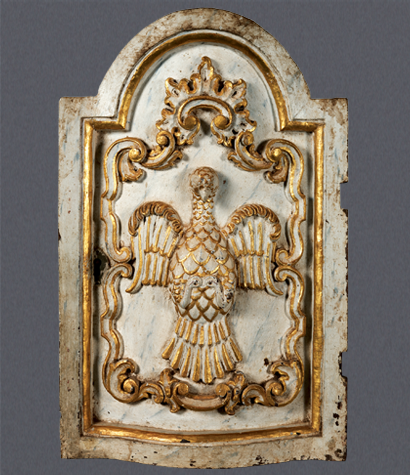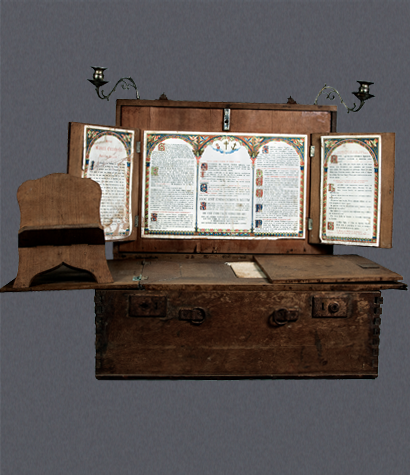
The tabernacle can be compared to a small temple with a closed, locked door that guards the consecrated Eucharist. It is secured to the altar or to an adjacent wall. This white-and-gold wood-carved tabernacle door is an arresting example of Indo-Portuguese art dating to the 18th century.
Tabernacles are generally decorated in period style. The central composition on this door is of a carved, gilded dove of the Holy Spirit in low relief. The dove is shown not still but hovering, its wings outstretched, tail fanning and claws contracted. The gilding on the painted white door makes visible details of the bird’s body- and tail feathers. At its lower body can be seen two fledglings, unusual in this context. In pre-Christian antiquity, the dove was the attribute of Venus, reimagined in Christian terms to symbolize the Holy Spirit. The gilded dove recalls very early tabernacles whose traditional form it constituted.
The carved, sinuous, gilded flourishes that frame the central composition culminate in symbolic vine leaves in outlined relief, reflecting the contents of the tabernacle. Revealing the actual shape of the door is a plain gold border emphasizing the carving.
While the time period and decorative flourishes seem to suggest the Baroque style, the colours of the tabernacle, white and gold, reveal the influence of the subtler Rococo style that succeeded it, popular in Goa in the 18th century. The door has the characteristic keyhole, and the indentations where the hinges were once fixed are visible.
NOTES
With regard to the influence of Rococo and other European art/architectural styles in Goa during different historical periods, see José Pereira, “Goan Architecture”.
REFERENCES
Pereira, José. “Goan Architecture,” Seminar, No. 543, New Delhi, 2004: https://bit.ly/2uAmQHA
PUBLICATIONS
Museum of Christian Art, Convent of Santa Monica, Goa, India, Calouste Gulbenkian Foundation, Lisbon, 2011.







